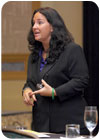Seminar Session: Jade Sund
In today’s fast-paced world, communication is critical, but just what are the most effective ways to get your message across? The answer just might depend on the person you’re dealing with, according to Jade Sund, founding trainer of ASK Training International, headquartered in Broomfield, Colo.

In today’s fast-paced world, communication is critical, but just what are the most effective ways to get your message across? The answer just might depend on the person you’re dealing with, according to Jade Sund, founding trainer of ASK Training International, headquartered in Broomfield, Colo.
Sund was a featured guest speaker the Best of Success Conference, and for her session titled “Speak so They Listen,” she brought with her a “preference test” for attendees. The contractors took the test and learned about their own preferred communication style. They also discovered what to look for in other’s speech and actions to determine the best way to get their message across.
“The feedback I received is that it was wonderful to understand why everyone didn’t receive information and understand words in the same way,” said Sund, who noted a number of contractors came up to her after the session and stated, “So that is why my wife doesn’t hear what I am saying!” “Why is that important?” Sund asked. “When you are speaking to the other person’s preference, you speak so they listen!”
Sund noted that there are four basic communication styles: visual, auditory, kinesthetic, and audio digital. “We have them all,” said Sund, “and usually one is more dominant.” In short, Sund characterized visual people as typically well organized and neat. She noted that they tend to memorize things by seeing pictures and often have trouble remembering verbal instructions. Visual people will be interested in how your program looks, and appearances are important to them, Sund noted.
Auditory people will often move their eyes from side to side and remember the exact words you said. They usually like music and are comfortable on the phone, said Sund, and they memorize material in steps, procedures and sequences.
Kinesthetic people respond to physical rewards, said Sund. They memorize by doing or walking through something, and will be interested in your program if it feels right to them or if there are items they can physically grasp.
Audio digital people will spend a fair amount of time talking to themselves, said Sund, but they are analytic and will know if your program makes sense. Understanding the program is very important to them, Sund indicated, and they have a tendency to dwell on things that have gone wrong. “Their natural way of being can seem to others as insensitive or disconnected,” Sund said, “but audio digitals are an important part of a successful team.”

Jade Sund, founding trainer for ASK Training International, tested contractors at the Best of Success Conference to help them gauge how they learn.
In today’s fast-paced world, communication is critical, but just what are the most effective ways to get your message across? The answer just might depend on the person you’re dealing with, according to Jade Sund, founding trainer of ASK Training International, headquartered in Broomfield, Colo.
Sund was a featured guest speaker the Best of Success Conference, and for her session titled “Speak so They Listen,” she brought with her a “preference test” for attendees. The contractors took the test and learned about their own preferred communication style. They also discovered what to look for in other’s speech and actions to determine the best way to get their message across.
“The feedback I received is that it was wonderful to understand why everyone didn’t receive information and understand words in the same way,” said Sund, who noted a number of contractors came up to her after the session and stated, “So that is why my wife doesn’t hear what I am saying!” “Why is that important?” Sund asked. “When you are speaking to the other person’s preference, you speak so they listen!”
Sund noted that there are four basic communication styles: visual, auditory, kinesthetic, and audio digital. “We have them all,” said Sund, “and usually one is more dominant.” In short, Sund characterized visual people as typically well organized and neat. She noted that they tend to memorize things by seeing pictures and often have trouble remembering verbal instructions. Visual people will be interested in how your program looks, and appearances are important to them, Sund noted.
Auditory people will often move their eyes from side to side and remember the exact words you said. They usually like music and are comfortable on the phone, said Sund, and they memorize material in steps, procedures and sequences.
Kinesthetic people respond to physical rewards, said Sund. They memorize by doing or walking through something, and will be interested in your program if it feels right to them or if there are items they can physically grasp.
Audio digital people will spend a fair amount of time talking to themselves, said Sund, but they are analytic and will know if your program makes sense. Understanding the program is very important to them, Sund indicated, and they have a tendency to dwell on things that have gone wrong. “Their natural way of being can seem to others as insensitive or disconnected,” Sund said, “but audio digitals are an important part of a successful team.”
Looking for a reprint of this article?
From high-res PDFs to custom plaques, order your copy today!


